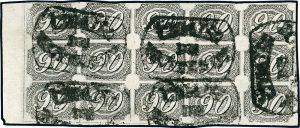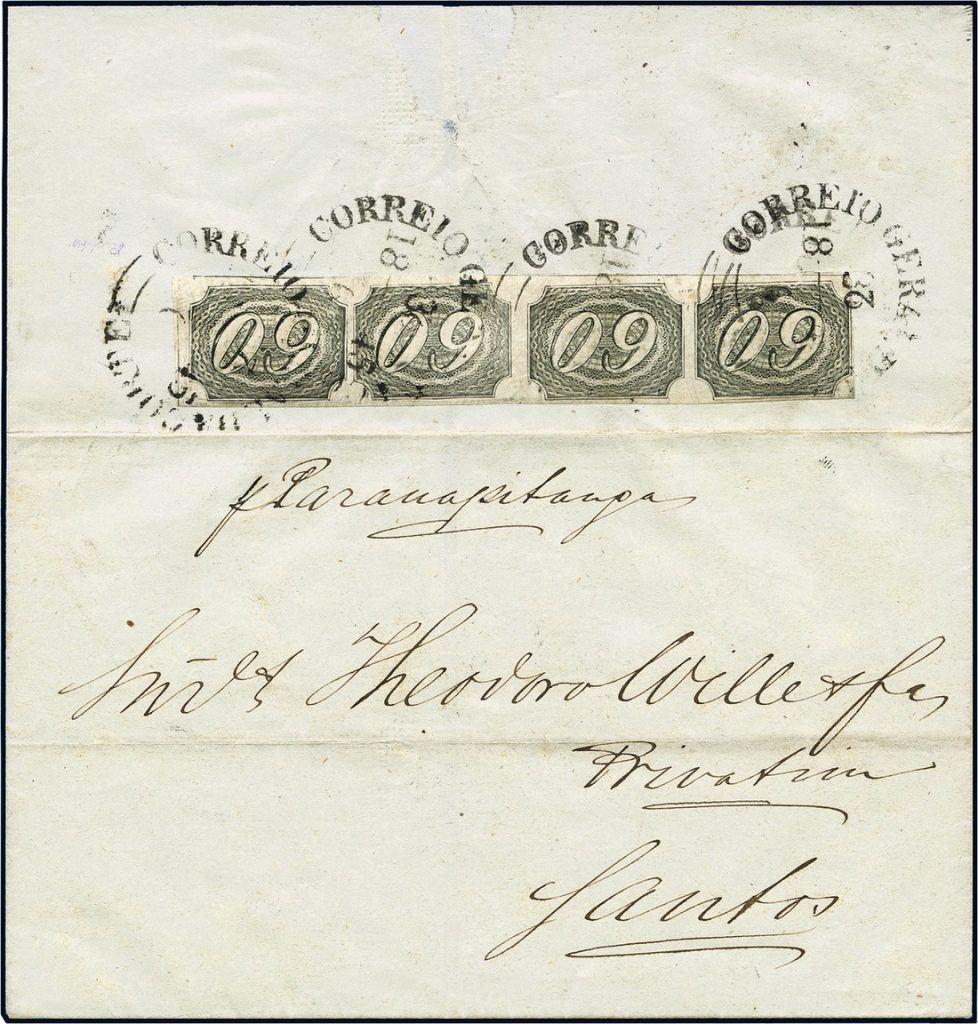Brazil’s Inclinados stamps—issued in 1844, only one year after Brazil’s famed “Bull’s Eye” stamps—brought record prices during Spink and Son’s sale of the “Inclinados Issues of Brazil” at the auction house’s U.S. headquarters.
Only the world’s second nation to issue stamps, Brazil originally released what became known as “Bull’s Eye” stamps in 1843 for use across the South American empire. Their creation is credited to J. D. Sturtz, a German employed as Brazilian consul to Prussia. Aware of the postal reforms in Britain, Sturtz endorsed similar reforms in Brazil, and in 1841, he succeeded in having a law passed to authorize postage stamps.
The stamps derive their nickname from their appearance, which includes large circles containing the stamps’ denominations. They were issued in se-tenant pairs, and their use resembled a pair of eyes peering out from the cover. The design was taken from elements used in the production of banknotes for the Imperial Bank of Brazil.
The “Inclinados”—or “Slanted Numerals”—were Brazil’s second issue, which followed the Bull’s Eye stamps and used Bull’s Eye paper. According to auctioneers, these are “very rare as this paper was used for a short period and few items have survived.”
One of the highlights of the Dec. 6-7 sale was Lot 17, the largest known multiple of 1844 60-reis stamps on cover. Described by auctioneers as “a delightful strip of four from the bottom right corner of the sheet, on very well preserved paper exhibiting a fresh white shade,” the stamps are tied by a ”Correio Geral Da Corte” handstamp of June 23, 1845 applied on reverse of the cover from Rio de Janeiro to Santos.
It’s believed to be the largest franking printed on the ”Bull’s Eye” paper on cover, and its rarity is further enhanced by comprising only the “Type II” variety which is scarcer than the other types. This “key postal history rarity for the advanced collection” brought $47,500 USD.
Another highlight was Lot 66, the largest multiple containing both “Type I” and “Type II” varieties of the 1845 90-reis stamp. Described by auctioneers as an “extraordinary block of fifteen on greyish paper,” this lot is one of the three multiples believed to exist featuring Type II in combination with Type I in the bottom two horizontal rows. The largest of the three multiples and a “unique and major rarity of Brazilian philately,” it sold for $125,000 USD.

Lot 66, the largest multiple containing both “Type I” and “Type II” varieties of the 1845 90-reis stamp, sold for $125,000 USD.
BULL’S EYE STAMPS
The Bull’s Eye stamps were unique because they did not contain the name of the issuing authority—a privilege now exclusively given to British stamps.
Furthermore, unlike Britain, which placed Queen Victoria on their first stamp issues, it wasn’t until 1866 that Brazil issued stamps featuring their monarch, Dom Pedro II. The reasoning was Brazilian authorities, noticing the zeal of British postal officials in cancelling stamps, did not want their emperor’s image being obliterated.
Originally, two plates of Bull’s Eye stamps were prepared. Each plate had 18 stamps organized into three rows of six with each of the three values (30-, 60- and 90-reis). The two lower values were for domestic use while the higher value was for international mail.
Because there was greater demand for the lower values, a third plate was prepared with 54 30-reis stamps. A fourth plate of 60 30-reis stamps as well as two other plates of 60 60-reis stamps were also prepared.
Printing volumes were rather high for the time. A total of 1.1 million 30-reis stamps; 1.5 million 60-reis stamps; and 349,000 90-reis stamps were printed; however, because of the series’ short lifespan and the way they were used, the stamps are considered rare today.
It was common practice in Brazil to use the stamps on the back of the cover, where they were affixed across the flap of the envelope to function as a seal. As a result, many of the stamps were destroyed when the letter was opened by the recipient.
The sale of Bull’s Eye stamps continued until Aug. 22, 1844.
In 1846, nearly half a million unissued Bull’s Eyes were burned by the Brazilian Mint.

